- About MAA
- Membership
- MAA Publications
- Periodicals
- Blogs
- MAA Book Series
- MAA Press (an imprint of the AMS)
- MAA Notes
- MAA Reviews
- Mathematical Communication
- Information for Libraries
- Author Resources
- Advertise with MAA
- Meetings
- Competitions
- Programs
- Communities
- MAA Sections
- SIGMAA
- MAA Connect
- Students
- MAA Awards
- Awards Booklets
- Writing Awards
- Teaching Awards
- Service Awards
- Research Awards
- Lecture Awards
- Putnam Competition Individual and Team Winners
- D. E. Shaw Group AMC 8 Awards & Certificates
- Maryam Mirzakhani AMC 10 A Awards & Certificates
- Two Sigma AMC 10 B Awards & Certificates
- Jane Street AMC 12 A Awards & Certificates
- Akamai AMC 12 B Awards & Certificates
- High School Teachers
- News
You are here
Who's That Mathematician? Paul R. Halmos Collection - Page 12
For more information about Paul R. Halmos (1916-2006) and about the Paul R. Halmos Photograph Collection, please see the introduction to this article on page 1. A new page featuring six photographs will be posted at the start of each week during 2012.
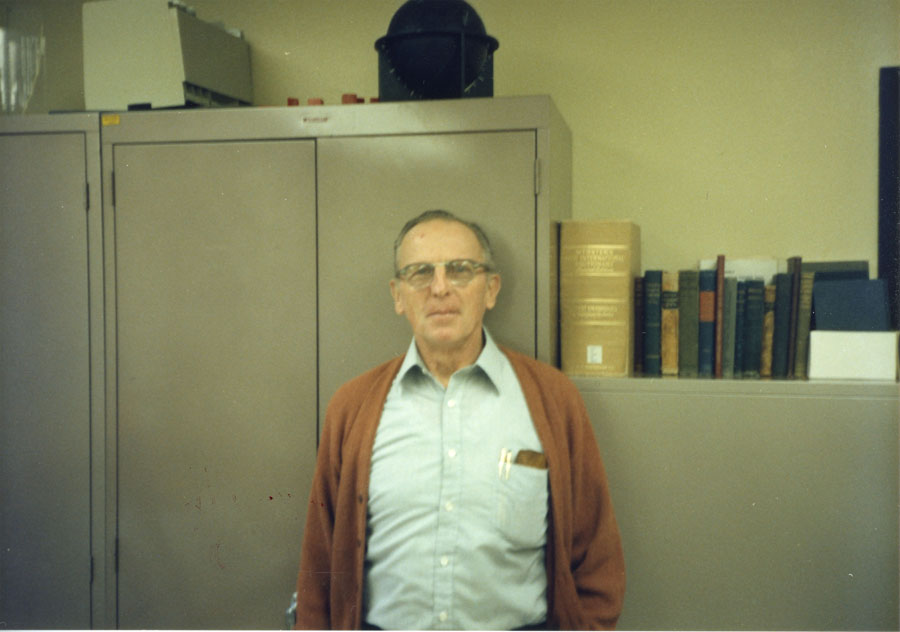
Halmos photographed Robert Dilworth (1914-1993) in October 1985 in Chico, California. Dilworth earned his Ph.D. at the California Institute of Technology (Caltech) in Pasadena, Calif., in 1939 with a thesis on lattice theory. After three years at Yale, he returned to Caltech in 1943, and spent his career there successfully transforming lattice theory "from being merely a tool of other disciplines to an important subject in its own right" (O'Connor and Robertson, MacTutor Archive). He also was interested in mathematics education, serving on various committees and boards to improve mathematics education in the U.S. and working on a project during the 1960s to develop primary and secondary mathematics curricula for various African nations (MacTutor Archive).
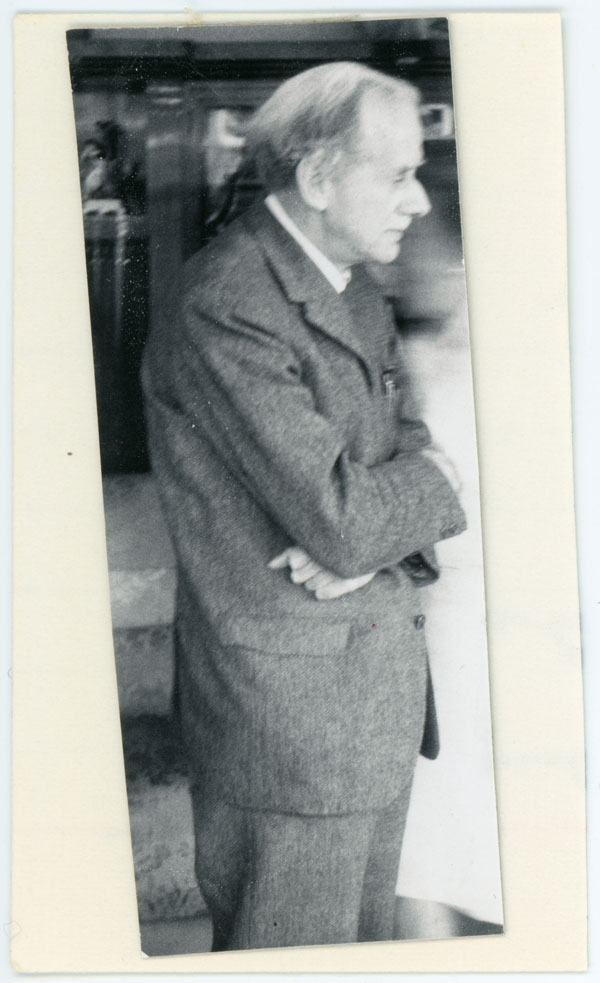
Paul Dirac (1902-1984) was photographed at a conference at Cambridge University on June 6, 1968. Dirac earned his Ph.D. at Cambridge in 1926 with a dissertation titled simply "Quantum Mechanics." In this dissertation, he formulated "for the first time a mathematically consistent general theory of quantum mechanics in correspondence with Hamiltonian mechanics," according to physicist Peter Higgs (quoted by O'Connor and Robertson, MacTutor Archive). By 1928, Dirac had connected quantum mechanics to relativity theory; during 1927-29, he travelled around the world (literally) visiting physicists and giving lectures; in 1932 he became Lucasian Professor of Mathematics at Cambridge; and in 1933 he was awarded the Nobel Prize in Physics for his work in quantum theory. Dirac retired from Cambridge in 1969 and moved to Florida, where he soon accepted a professorship at Florida State University in Tallahassee and continued his research and his travels. (Additional source: Nobel Prize Biography from Nobel Lectures, Physics 1922-1941, Elsevier Publishing Company, Amsterdam, 1965)
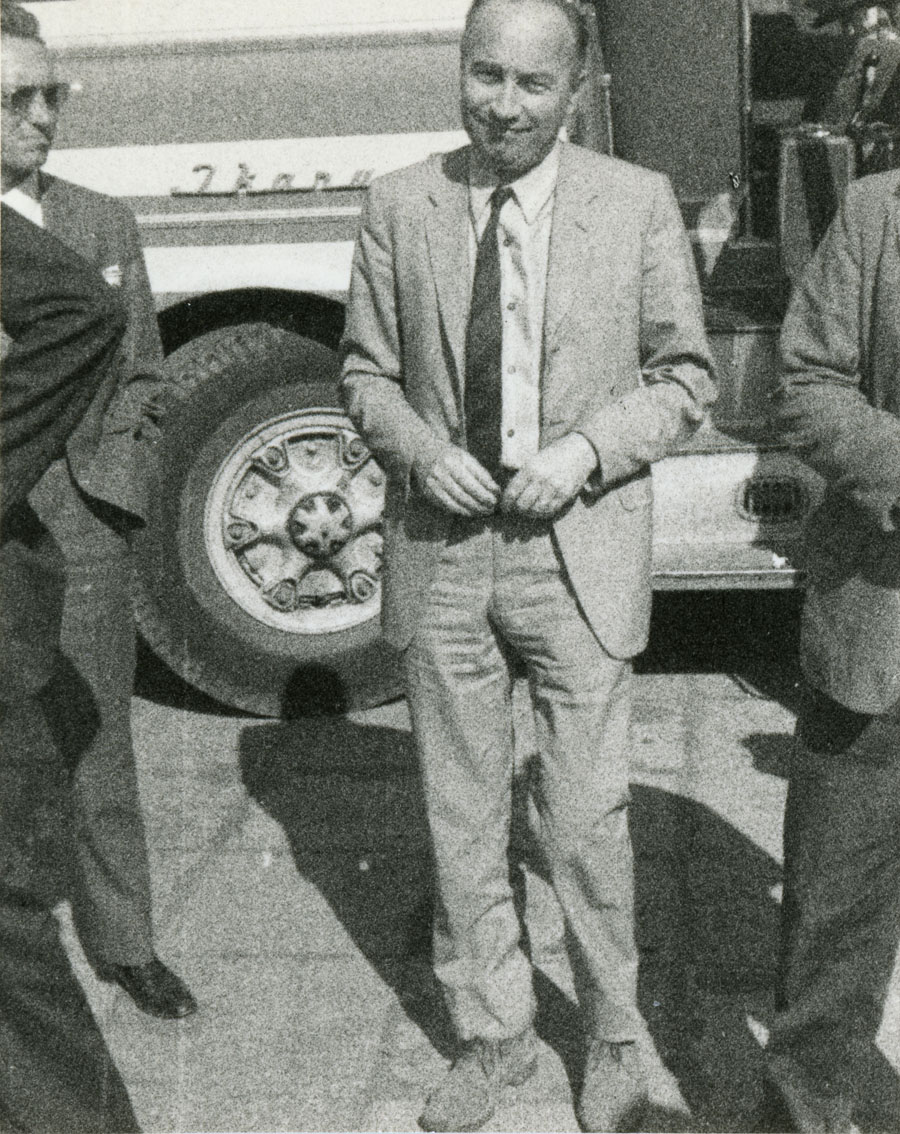
Halmos photographed Jacques Dixmier in September 1970 at a conference in Tihany, Hungary. Dixmier earned his Ph.D. in 1949 at the University of Paris under Gaston Julia and spent most of his career at various branches of the University of Paris, advising 20 Ph.D. students in all. He learned about Hilbert spaces from Julia and made them his initial research area. Like Jean Dieudonné (see page 11 of this collection), he credits his participation in the Bourbaki from 1949 onward with introducing him to new (albeit related) research areas, including operator algebras, C*-algebras, unitary representation theory, enveloping algebras, and invariant theory. (Source: Martin Raussen, "Interview with Jacques Dixmier," Newsletter of the European Mathematical Society, June 2009, 34-41, ISSN 1027-488X)
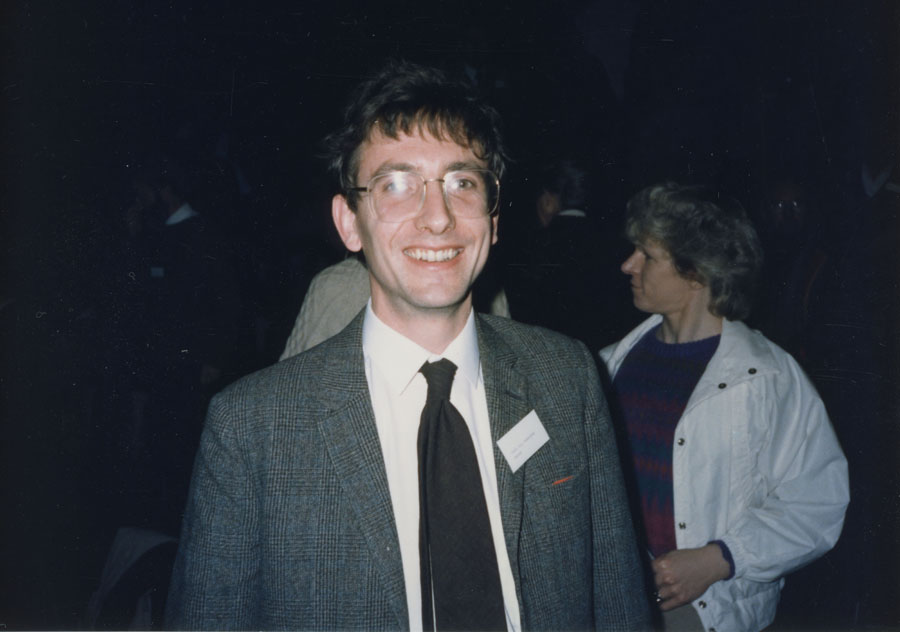
Simon Donaldson is pictured in April 1986 at the British Mathematical Colloquium in Hull, England. Paul Halmos was a plenary speaker at this BMC, on "Fifty Years of Linear Algebra: A Personal Reminiscence," and Donaldson a "morning speaker" on "Geometry of 4-manifolds" (MacTutor Archive). Donaldson was awarded the Fields Medal a few months later at the 1986 International Congress of Mathematicians in Berkeley, California, "primarily for his work on topology of four-manifolds, especially for showing that there is a differential structure on [Euclidean] four-space which is different from the usual structure" (IMU Fields Medallists). His Ph.D. advisor, Michael Atiyah, wrote in the ICM Proceedings (quoted by O'Connor and Robertson, MacTutor Archive):
In 1982, when he was a second-year graduate student, Simon Donaldson proved a result that stunned the mathematical world. ... Donaldson's result implied that there are "exotic" 4-spaces, i.e. 4-dimensional differentiable manifolds which are topologically but not differentiably equivalent to the standard Euclidean 4-space .... What makes this result so surprising is that n = 4 is the only value for which such exotic n-spaces exist.
Donaldson earned his doctorate at Oxford University in 1983 with the dissertation "The Yang-Mills Equations on Kähler Manifolds," and was Wallis Professor of Mathematics at Oxford until he moved to Imperial College, London, in 1999. He has advised at least 40 Ph.D. students, most of them at Oxford, but, since 2002, eight of them at the University of London and one (2009) at Imperial College (Mathematics Genealogy Project and MacTutor Archive).
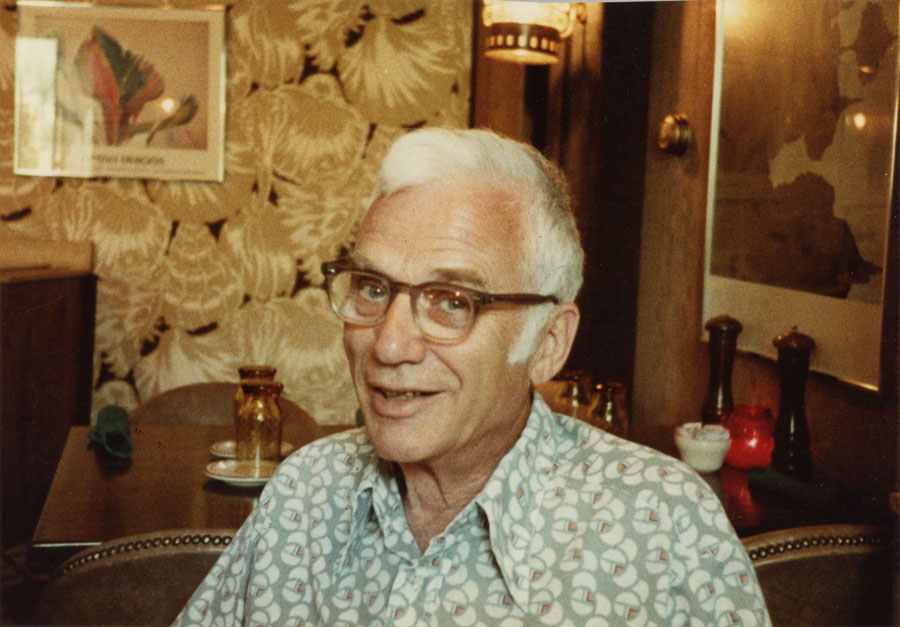
Halmos photographed his Ph.D. advisor Joseph Doob (1910-2004) in July 1984 in Urbana, Illinois. Doob earned his Ph.D. at Harvard University in 1932 on "Boundary Values of Analytic Functions." He first studied his specialty, probability, under the direction of statistician Harold Hotelling, during the final year, 1934-35, of a three-year post-doctoral position at Columbia University. In 1935, he became a mathematics professor at the University of Illinois, Urbana-Champaign, where he spent the rest of his career. Paul Halmos was Doob's very first Ph.D. student at Illinois, graduating in 1938, and Warren Ambrose (1939) and David Blackwell (1941) soon followed. All three wrote dissertations in probability theory (MacTutor Archive). For a photograph of Doob, Halmos, Ambrose, and Blackwell, see page 1 of this collection; for a photo of Ambrose, see page 1; and for photos of Blackwell, see page 7. Additional photos of Joseph Doob appear below and on page 2 of this collection.
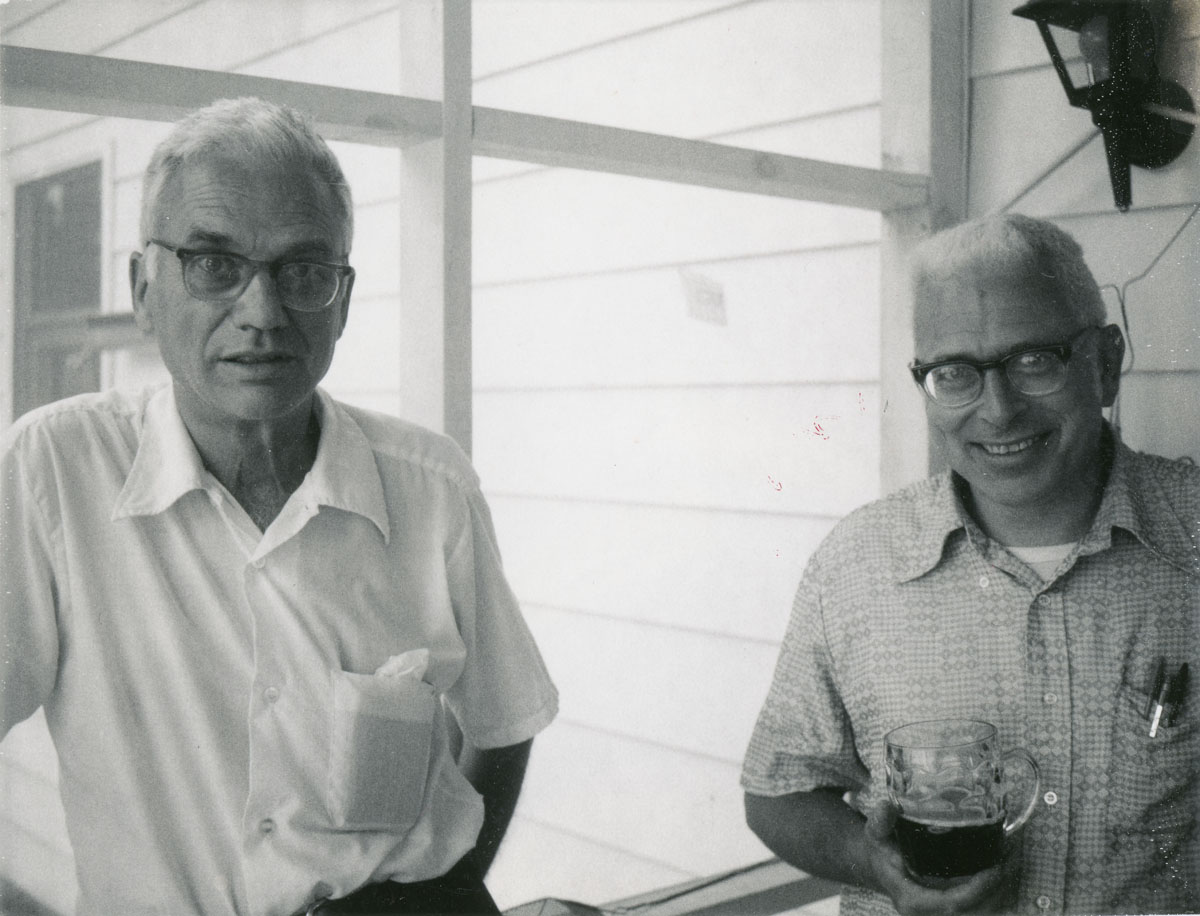
Joseph Doob and Murray Rosenblatt were photographed on August 1, 1974, in Bloomington, Indiana, where Halmos was professor of mathematics at Indiana University.
Joseph Doob's specialties were probability and measure theory, including stochastic processes, martingale theory, and potential theory (MacTutor Archive). He served as president of the American Mathematical Society in 1963-64 (AMS Presidents) and received the National Medal of Science in 1979 (MacTutor Archive).
Probabilist and statistician Murray Rosenblatt earned his Ph.D. at Cornell University in 1949 under advisor Mark Kac. After stints at the University of Chicago (where he and Halmos probably first met), Indiana University, and Brown University, he moved in 1964 to the brand-new University of California, San Diego, where he is now emeritus. Although Rosenblatt's specialties are time series and Markov processes, his research has spanned a variety of topics in probability and statistics. He has advised at least 22 Ph.D. theses. (Sources: Mathematics Genealogy Project; UC San Diego Mathematics Department; History of UC San Diego; D. R. Brillinger and R. A. Davis, "A Conversation with Murray Rosenblatt," Statistical Science 24:1 (2009), 116–140, DOI: 10.1214/08-STS267)
For an introduction to this article and to the Paul R. Halmos Photograph Collection, please see page 1. Watch for a new page featuring six new photographs each week during 2012.
Regarding sources for this page: Information for which a source is not given either appeared on the reverse side of the photograph or was obtained from various sources during 2011-12 by archivist Carol Mead of the Archives of American Mathematics, Dolph Briscoe Center for American History, University of Texas, Austin.
Janet Beery (University of Redlands) and Carol Mead (Archives of American Mathematics, University of Texas, Austin), "Who's That Mathematician? Paul R. Halmos Collection - Page 12," Convergence (January 2012), DOI:10.4169/loci003801




